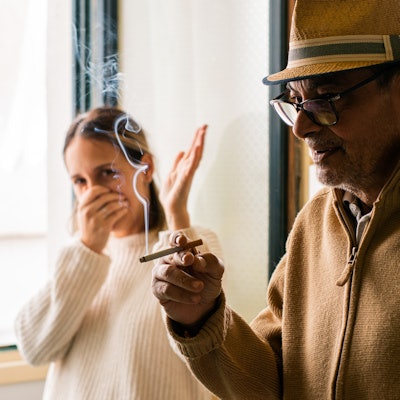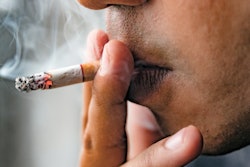
Exposure to secondhand tobacco smoke may increase a person's risk of developing lip, mouth, and throat cancers by more than 50%, according to a systematic review published on April 26 in Tobacco Control.
Those who breathe in secondhand smoke for more than 10 to 15 years may be twice as likely to develop oral cancer as people not exposed to passive smoke, the authors wrote.
"Our systematic review and meta-analysis support a consistent and statistically significant association between [secondhand smoke] exposure and the risk of oral cancer," wrote the group, led by Kurt Straif, PhD, a visiting professor at the Schiller Institute for Integrated Science and Society at Boston College in Chestnut Hill, MA.
Health goes up in smoke
Smoking is linked to numerous diseases and negatively affects oral health, causing more dental plaque and worsening existing gum disease. Evidence has shown that exposure to secondhand smoke may cause inflammation in the oral cavity and impair salivary gland function, and it may directly affect teeth and microorganisms found in the mouth.
Smoking tobacco, using smokeless tobacco, drinking alcohol, and chewing betel quid are also known to increase the risk of developing oral cancers. Oral cancers account for approximately 448,000 new cases of cancer and about 228,000 deaths annually worldwide, according to the cancer statistics platform Global Cancer Observatory.
Despite these statistics, researchers believe the relationship between secondhand smoke and oral cancers has not been thoroughly examined. In 2009, the International Agency for Research on Cancer confirmed there was sufficient evidence to conclude that secondhand tobacco smoke is carcinogenic to humans and that exposure to the smoke causes lung cancer. Additionally, a positive link was reported between secondhand smoke exposure and cancers of the larynx and the pharynx, but not for any other cancer sites.
Since the agency's evaluation, several studies have been published that further examine the risks of passive smoking and oral cancer. However, they have not been included in a systematic review and meta-analysis until now, the authors wrote.
To analyze potential links between secondhand smoke exposure and oral cancer risk, the researchers conducted a systematic review of studies published through May 10, 2020. They analyzed five studies that included a total of 6,977 people. Of those, 3,452 individuals were exposed to secondhand smoke and the remaining 3,525 were not exposed to smoke. These studies were conducted in North America, Asia, Europe, and Latin America.
Risk revealed
People who were exposed to smoke from burning cigarettes but who were not smokers themselves saw their risk of oral cancer increase by 50%, with an overall odds ratio of 1.51 (p = 0.0004), the authors wrote.
Those exposed to more than 10 or 15 years of secondhand smoke were more likely to develop oral cancer, with an odds ratio of 2.07 (p = 0.00001), than those who were not exposed to tobacco smoke.
The study did have several limitations, including the small number of studies included in the analysis. However, the overall number of cases and controls in the meta-analysis was high because several of the original studies pooled many individual studies. Future studies should be conducted to strengthen the evidence and address the limitations, they noted.
The review shows a consistent, significant association between secondhand smoke exposure and the risk of oral cancer, and the duration of exposure supports causal inference; therefore, the results should be used to adopt appropriate preventive measures within the World Health Organization's Framework Convention on Tobacco Control, the authors wrote.
"The identification of the harmful effects of [secondhand smoke] exposure provides guidance to public health professionals, researchers, and policymakers as they develop and deliver effective [secondhand smoke] exposure prevention programs," they concluded.




















